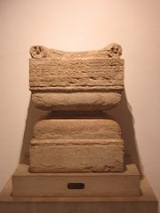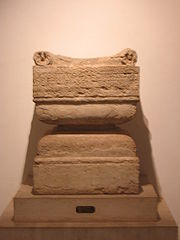
Si deus si dea
Encyclopedia
Si deus si dea is an Archaic Latin phrase meaning "whether god
or goddess
", used to address a deity of unknown gender. It was also written sive deus sive dea, sei deus sei dea, or sive mas sive femina ("whether male or female").
The phrase can be found on several ancient monuments. Archaic Roman inscriptions such as this might have written to protect the identity of the god if Rome were ever captured by an enemy. The construction was often used when invoking the god of a place (e.g., "Be you god or goddess who reigns over Carthage, grant us..."). Historian Edward Courtney believes it was "intended to cover all bases as an acknowledgement of the limitations of human knowledge about divine powers," similar to the Greek Unknown God
.
 In 1820, an altar was discovered on the Palatine Hill
In 1820, an altar was discovered on the Palatine Hill
with an Old Latin
inscription,
which can be transliterated into the modern alphabet as
and translated as
The altar has been dated as a late Roman Republic
restoration of an Archaic original. In the 19th century it was misidentified as a famous altar to Aius Locutius
, but the real identity of the divinity cannot be known, as it is not even specified whether it is a god or a goddess. The praetor Caius Sextius C.f. Calvinus may have restored an earlier altar reading "sei deo sei deivae" for the reasons described above, or he may have been restoring an altar which had been forgotten and left to decay, and the god or goddess it was dedicated to was no longer remembered by any Roman.
." Column C reads "anabestas," possibly a goddess named Anabesta, or else related to the Greek anabasio ("to go up") and interpreted as a reference to Remus' scaling of the Roman walls. Column D, the longest inscription, reads:
Livy ascribes the institution of the fetiales to Ancus Marcius , and claims that the ius fetiale came to Rome by the Aequicoli.
God (male deity)
A god, as a male deity, contrasts with female deities, or "goddesses". While the term 'goddess' specifically refers to a female deity, the plural 'gods' can be applied to all gods collectively, regardless of gender....
or goddess
Goddess
A goddess is a female deity. In some cultures goddesses are associated with Earth, motherhood, love, and the household. In other cultures, goddesses also rule over war, death, and destruction as well as healing....
", used to address a deity of unknown gender. It was also written sive deus sive dea, sei deus sei dea, or sive mas sive femina ("whether male or female").
The phrase can be found on several ancient monuments. Archaic Roman inscriptions such as this might have written to protect the identity of the god if Rome were ever captured by an enemy. The construction was often used when invoking the god of a place (e.g., "Be you god or goddess who reigns over Carthage, grant us..."). Historian Edward Courtney believes it was "intended to cover all bases as an acknowledgement of the limitations of human knowledge about divine powers," similar to the Greek Unknown God
Unknown God
The Unknown God or Agnostos Theos is a theory by Eduard Norden first published in 1913 that proposes, based on Paul's Areopagus speech in Acts 17:23, that in addition to the twelve main gods and the innumerable lesser deities, ancient Greeks worshipped a deity they called "Agnostos Theos", that...
.
Altar to the Unknown Divinity

Palatine Hill
The Palatine Hill is the centermost of the Seven Hills of Rome and is one of the most ancient parts of the city...
with an Old Latin
Old Latin
Old Latin refers to the Latin language in the period before the age of Classical Latin; that is, all Latin before 75 BC...
inscription,
- SEI•DEO•SEI•DEIVAE•SAC
- G•SEXTIVS•C•F•CALVINVSPR
- DE•SENATI•SENTENTIA
- RESTITVIT
which can be transliterated into the modern alphabet as
- Sei deo sei deivae sac(rum)
- G(aius) Sextius C(aii) f(ilius) Calvinus pr(aetor)
- de senati sententia
- restituit
and translated as
- Whether to a god or goddess sacred,
- Caius Sextius Calvinus, son of Caius, praetor
- by order of the Senate
- restored this.
The altar has been dated as a late Roman Republic
Roman Republic
The Roman Republic was the period of the ancient Roman civilization where the government operated as a republic. It began with the overthrow of the Roman monarchy, traditionally dated around 508 BC, and its replacement by a government headed by two consuls, elected annually by the citizens and...
restoration of an Archaic original. In the 19th century it was misidentified as a famous altar to Aius Locutius
Aius Locutius
Aius Locutius or Aius Loquens , was a Roman deity or numen associated with the Gallic invasions of Rome during the early 4th century BC....
, but the real identity of the divinity cannot be known, as it is not even specified whether it is a god or a goddess. The praetor Caius Sextius C.f. Calvinus may have restored an earlier altar reading "sei deo sei deivae" for the reasons described above, or he may have been restoring an altar which had been forgotten and left to decay, and the god or goddess it was dedicated to was no longer remembered by any Roman.
Ferter Resius
Close to the site, four inscribed columns were found dating to the Julio-Claudian period. Column A (now missing) read "Marspiter," or "Father Mars" in Archaic Latin. Column B reads "Remureine," which possibly means "In Memory of RemusRemus
Remus is the twin brother of the mythical founder of Rome.Remus may also refer to:* Remus , a fictional planet in Star Trek* Remus , a moon of the asteroid 87 Sylvia...
." Column C reads "anabestas," possibly a goddess named Anabesta, or else related to the Greek anabasio ("to go up") and interpreted as a reference to Remus' scaling of the Roman walls. Column D, the longest inscription, reads:
- Ferter Resius / rex Aequeicolus / is preimus / ius fetiale paravit / inde p(opulus) R(omanus) discipleinam excepit.
- Ferter Resius, / Aequicolean (= AequeanAequithumb|300px|Location of the Aequi in central Italy.The Aequi were an ancient people of northeast Latium and the central Appennines of Italy who appear in the early history of ancient Rome. After a long struggle for independence from Rome they were defeated and substantial Roman colonies were...
) king, / he first / introduced the ius fetiale, / from him the Roman people / learned the discipline [of making treaties].
- Ferter Resius, / Aequicolean (= Aequean
Livy ascribes the institution of the fetiales to Ancus Marcius , and claims that the ius fetiale came to Rome by the Aequicoli.
Further reading
- Alvar, Jaime, 1988: "Materiaux pour l'etude de la formule sive deus, sive dea" Numen 32,2, 236-273.

